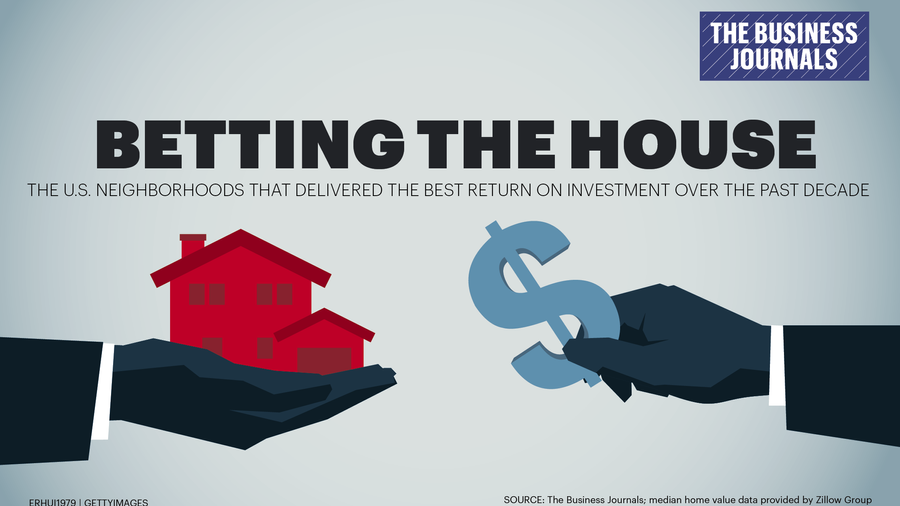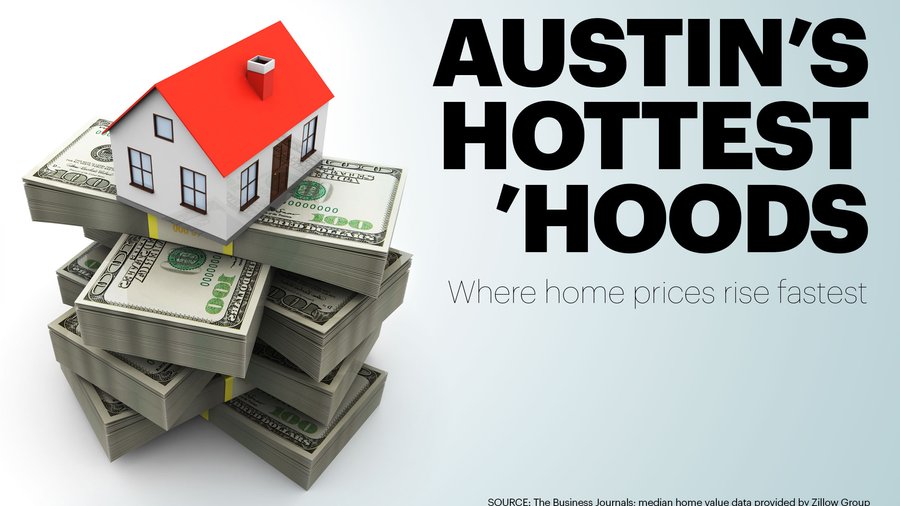There's no doubt that money is flooding into East Austin, generating wealth for this long-time minority neighborhood while putting pressure on others.
The area is a bastion of economic development and office projects are rapidly popping up due largely to the relatively inexpensive cost of building compared to the Central Business District.
But even the most astute real estate observer might be surprised at just how much housing prices have risen east of I-35 during the past decade. The Business Journals crunched reams of housing data from Zillow Group Inc. (Nasdaq: Z) to identify some of the fastest-growing neighborhoods across the country, including in Austin.
If you're looking to buy a fast-appreciating house, you may have missed the boat in these neighborhoods. So Austin Business Journal also reached out to local Realtors to forecast where home values will climb fastest in the next decade.
Consider that a median-priced home in East Austin ZIP code 78721 cost $137,400 in 2009, near the end of the last recession. The median home value in the ZIP code jumped 130% over the past decade to $315,400 in 2019, making it the fastest-appreciating neighborhood in the city of Austin, according to Zillow.
Located just south of Mueller, 78721 boasts proximity to that big, new neighborhood as well as downtown Austin. But what has really driven its surge in value over the past 10 years was its starting point, said Chris Watters, founder of Watters International Realty. He can recall selling homes in that area for $60,000 or $70,000 within the past decade, just as the redevelopment of Mueller began changing the area's trajectory.
“It drew in a much higher profile of potential buyer, and just changed the entire area," Watters said of Mueller. "There hasn’t been anything else happen like that in Austin in decades.”
ZIP code 78758, tucked between MoPac Expressway and I-35 in North Austin, has seen the second-biggest jump in home prices in the past decade: a 117% increase. It was the only other Austin ZIP code to see the median home price double from 2009 to 2019.
The area has already been bolstered by The Domain and Realtor Jonny Rodgers of Den Property Group anticipates further growth after the 2021 arrival of Austin FC. The city's forthcoming Major League Soccer franchise is building a stadium at a 24-acre North Austin site called McKalla Place.
“The Domain, I think, has really saved Austin in a lot of different ways. You didn’t have those options in North Austin like you did in downtown," Rodgers said. “When Austin FC gets on up there in North Austin, that’s going to be a really fun place to be.”
Realtor Amy Bernhard of Realty Austin points to the wealth of tech talent in North Austin as another plus for the area.
“I feel like the draw to North Austin is going to remain strong and get stronger over time because of the tech companies and the access to The Domain," she said.
Rodgers noted that it took investment from out-of-towners to truly spark the East Austin real estate boom.
“A lot of people from Austin didn’t necessarily see the value of East Austin from a long-term perspective," Rodgers said. “The good news is there’s a lot of Austin families that made money. These are homes that were passed down from generation to generation.”
Use the tool below to explore growth in home values nationwide, and check out the slideshow above for the top ZIP codes in Austin city limits.
The 20 ZIP codes featured in the slideshow atop this page don't even include Austin’s most expensive area: ZIP code 78746, which hugs the Colorado River to the south and west of downtown Austin. Encompassing both Zilker Park and portions of the Barton Creek Greenbelt, 78746 is Austin’s lone million-dollar neighborhood — where the median home value is in the seven figures. The posh ZIP code boasts a median home value of $1,037,000, according to Zillow.
There may soon be a second entrant into the exclusive million-dollar neighborhood club. ZIP code 78703 — encompassing Tarrytown and swaths of downtown — reached a median home value of $994,000 in August. That’s up from $548,600 in 2009, an 81% increase.
Of course, this kind of meteoric growth in property value is a double-edged sword. Homeowners are having to dig deeper into their wallets than ever, while renters in these hot ZIP codes are almost assuredly facing regular rent increases as values soar. The issue of affordability is a serious enough concern that the city of Austin has taken a couple of cracks at overhauling its land development code to address two of Austin’s preeminent issues: affordable housing and mobility.
“The only way pricing is going to stabilize in Austin is if we get some kind of zoning change where we can build higher-density housing," said Watters.
Meanwhile, the city’s Austin Strategic Housing Blueprint calls for roughly 60,000 new or preserved affordable housing units over the next decade — a tall order, many experts said.
THE FAST-GROWING ZIP CODES OF THE FUTURE
There doesn’t appear to be an end in sight to the housing boom, as a closely watched report from PricewaterhouseCoopers and Urban Land Institute recently listed Austin as the top city in the country for real estate investment in 2020.
The median single-family home price hit $406,000 in September in Austin proper, a record for the month. That was up 11.9% from the same month in 2018, according to the Austin Board of Realtors.
Just about the only factor hindering the Austin real estate market is the lack of available housing stock. The most recent monthly report from Austin Board of Realtors found that the city of Austin has just 1.6 months of housing inventory; real estate experts consider at least six months of inventory necessary for a market with balanced supply and demand.
And Realtors still see reason for optimism. Looking ahead to the next decade, Bernhard thinks ZIP code 78754, north of Mueller and east of I-35, could be among the neighborhoods where median home values grow fastest over the next decade.
“That one I think is still for pioneers. There’s not much up there yet that is appealing in and of itself, other than the prices," Bernhard said. "You can get prices that people could get two or three years ago in 78723 or 78721.”
Watters said investors and potential homeowners should be looking at the city's periphery for value.
“It’s going to be the suburb areas where the price point is between $250,000 and $400,000," Watters said. "That’s Cedar Park and Leander, Round Rock and Georgetown.”
Rodgers, meanwhile, believes the next area primed for meteoric growth is South Austin, along the I-35 corridor.
"I think 10 years from now, the Austin-San Antonio corridor looks a lot different," he said. "As those cities continue merging that’s where people are going to see success and gains in real estate.”
A NATIONAL LOOK AT HOUSING HOTSPOTS
The Business Journals' analysis tracked home values from the depths of the recession in August 2009 through August of this year, and applied a hypothetical scenario in which homebuyers entered the market a decade ago with a 10% downpayment to make a purchase. In Lawrenceville, Pennsylvania, in August 2009, that downpayment would have equaled about $7,000 for the median home value at the time of $69,800, according to data provided by Zillow Group. As of August, the area's median home had appreciated to $217,200 in value, a $147,400 gain for our hypothetical homebuyer.
Nationally, the returns to homebuyers over the past decade have been almost universally healthy. Among the thousands of ZIP codes covered in The Business Journals' study, the median home in some 12,885 of those locations appreciated in value, with a median price change of 31% over a decade.
Many areas ravaged by the most-recent recession and housing downturn have seen some of the strongest rebounds in value during the subsequent 10 years. For example, 191 of those communities were located in either California, Colorado or Arizona, where a surplus of housing inventories at the recession's onset led to a flood of foreclosures and slashed home values.
In dollar terms, the neighborhood to see the greatest appreciation over the past decade was New York's 10021 ZIP code, home to Park Avenue and a median home value of $15.4 million as of August. The median home in that neighborhood appreciated by about 37% over that span, enough to add about $3 million in paper profits for a typical home purchase a decade ago. Rounding out the top three dollar-gainers were Beverly Hills 90210 (up $3.2 million, or 130%, over the decade) and the Silicon Valley suburb of Atherton, California (up $3 million, or 100%).
Of the 2,000 or so neighborhoods to see home values stagnate or decline over the past 10 years, the worst fallout was concentrated in the nation's Rust Belt and in particular the state of Illinois. Among the bottom 25 performers, eight were in the Land of Lincoln, with another six located in Missouri.







The U.S. neighborhoods that delivered the best return on investment over the past decade.
Craig Douglas of American City Business Journals contributed to this report.









